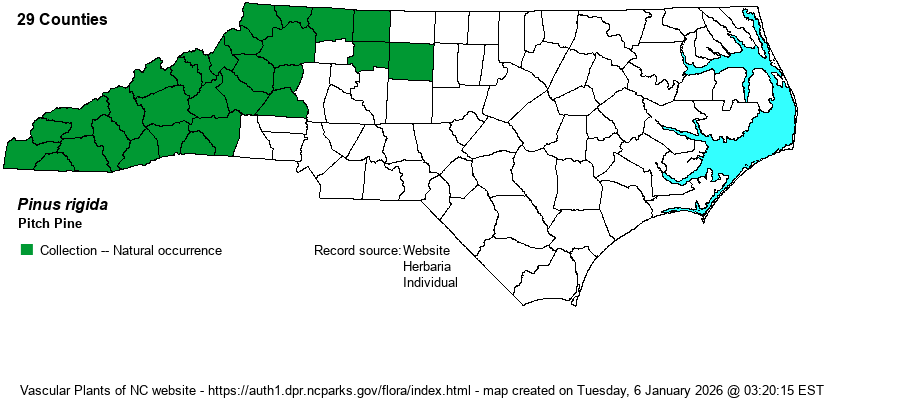| Author | P. Miller | |
| Distribution | Throughout the Mountains, and into the western and rarely the central Piedmont; limited essentially to ridges and monadnocks in the Piedmont. Ranges east to Guilford County. An old specimen from Randolph County at NCU has been re-examined and determined to be a hybrid with Loblolly Pine (P. taeda) i.e., is P. rigida x taeda.
This is a Northeastern species, ranging from southern Que and southern Ont south to NJ, PA, and OH, and then in the Appalachians and foothills to northwestern SC and northern GA. | |
| Abundance | Fairly common in the Mountains, being somewhat less local or restricted than Table Mountain Pine (P. pungens), but often growing with it in both the Mountains and upper Piedmont. It is uncommon and local in the western Piedmont, and very rare eastward to Guilford County (where probably no longer extant). | |
| Habitat | This species grows mostly on dry ridges, especially on south-facing or rocky slopes. It also grows on monadnocks, around rock outcrops, and other dry sites, but less so in overly rocky or exposed sites where Table Mountain Pines are more numerous. Unlike some other montane pines, it also grows in some bogs, at least where peaty (and acidic). |
| Phenology | Pollen is released mainly in May, and cones mature mainly in September and October. | |
| Identification | This is a rather familiar montane tree, growing to medium size, to about 50-60 feet tall. It is somewhat stocky in looks, with a rounded crown, a bit more “elegant” than Table Mountain Pine. It is shorter and has a more rounded crown than Shortleaf Pine (P. echinata), but it is more sturdy than the rather slender Virginia Pine (P. virginiana). The needles are in bundles of 3, somewhat stocky, and twisted; the other similar montane pines have needles mainly in 2s. The needles are a bit longer than those of the other three species, averaging 4 inches long. The cones are somewhat “normal” looking, of medium size, and about 2-2.5 inches long, with prickles on the scales. Separating these four pines in the western part of the state is not difficult if you are hiking and can observe them up close, such as seeing that this species has 3 needles in all fascicles; but if you are driving, trying to identify them from a moving vehicle, it may be tricky. | |
| Taxonomic Comments | None, though the occasional old reference lumped Pond Pine (P. serotina) with this, forcing this taxon to be named as P. rigida ssp. rigida.
| |
| Other Common Name(s) | Hard Pine | |
| State Rank | S4 | |
| Global Rank | G5 | |
| State Status | | |
| US Status | | |
| USACE-agcp | FACU link |
| USACE-emp | FACU link |

